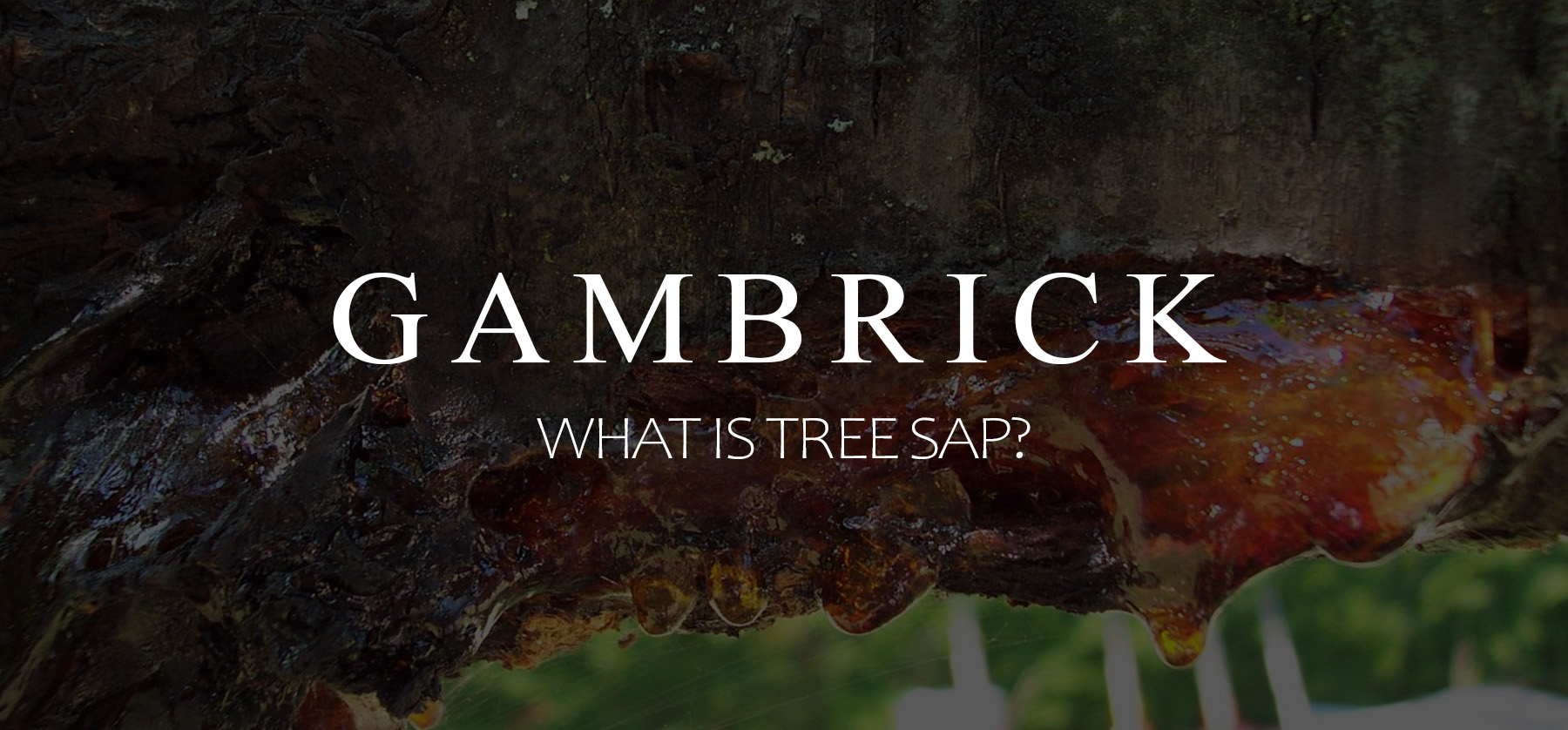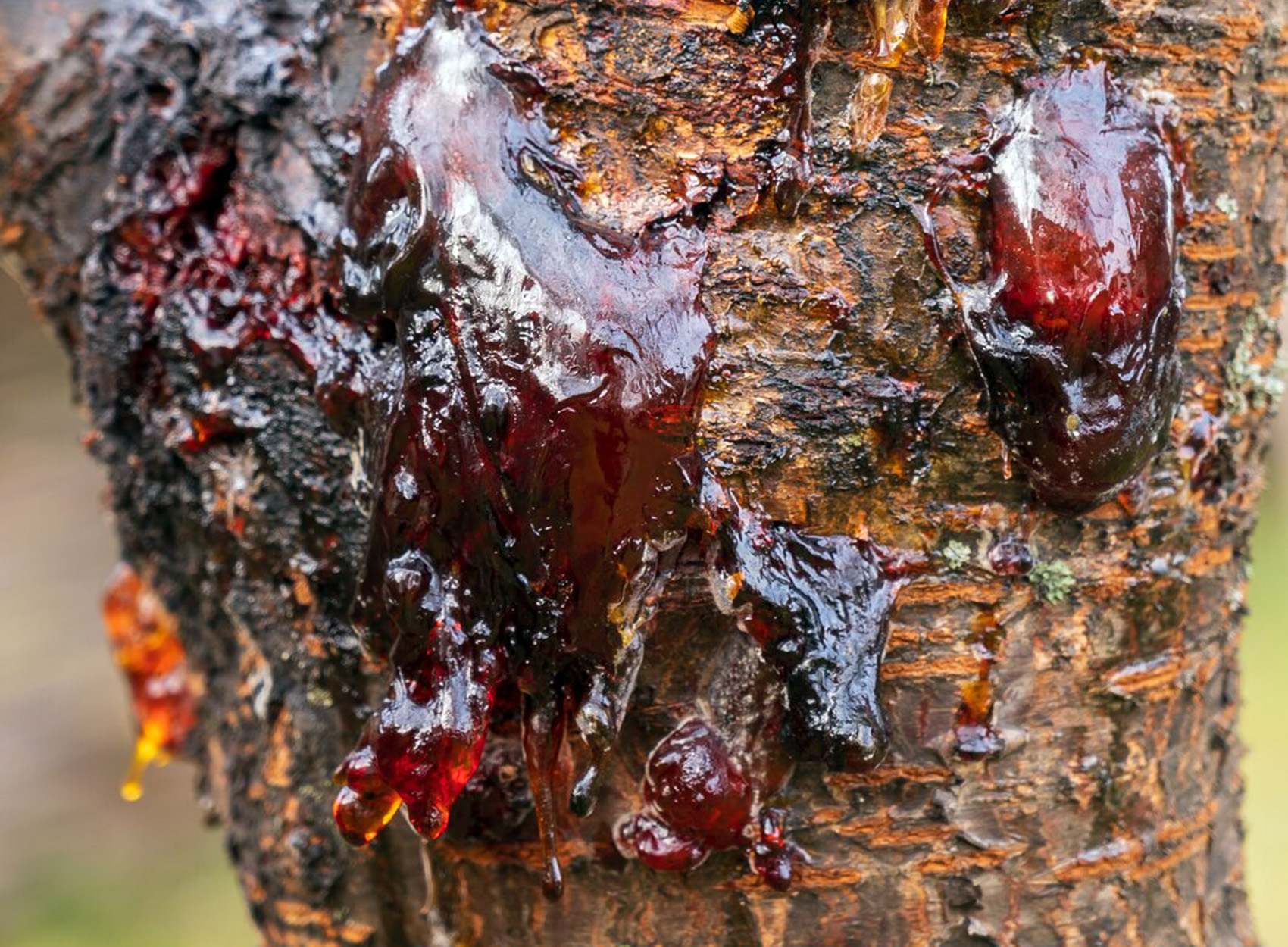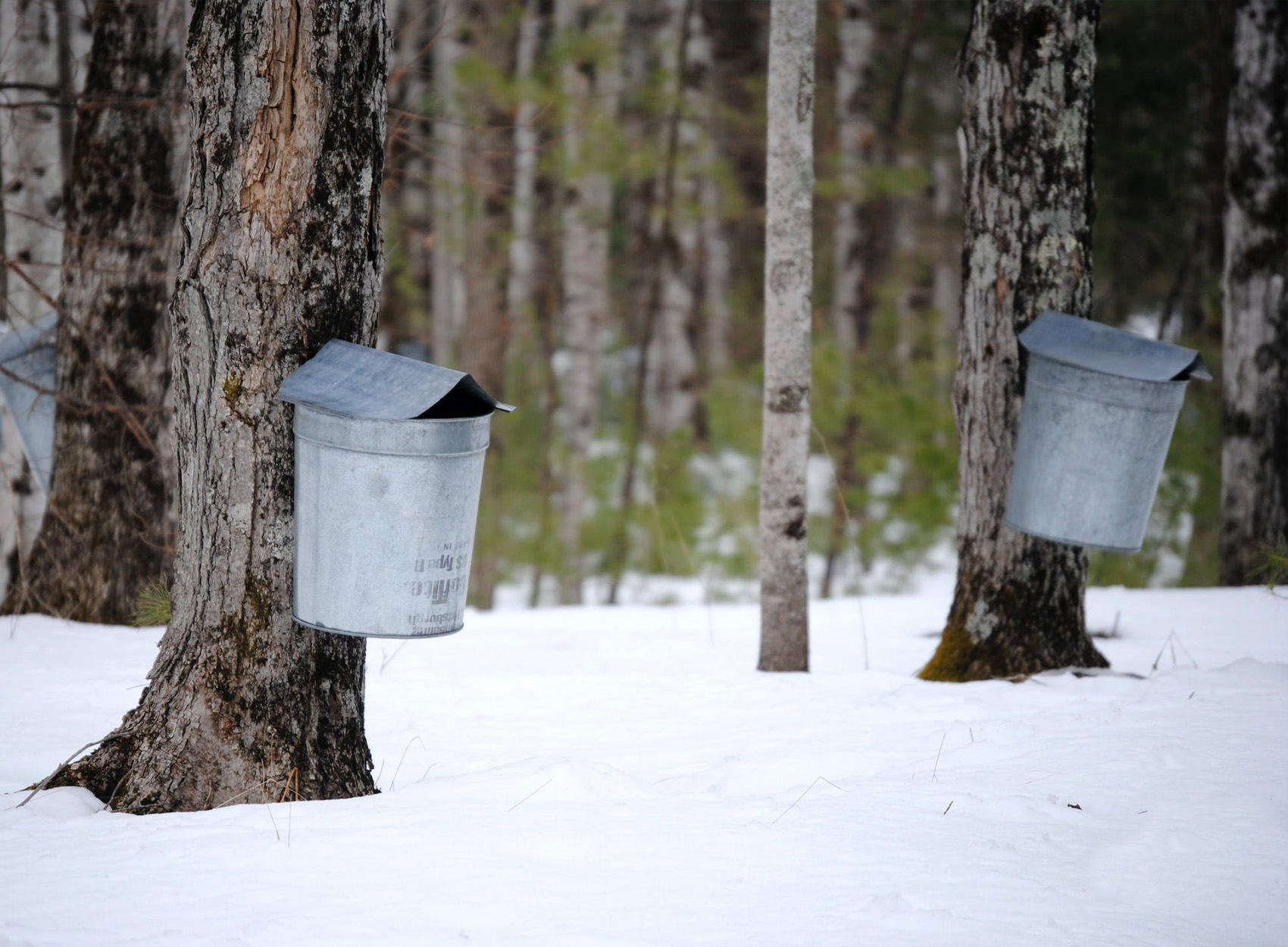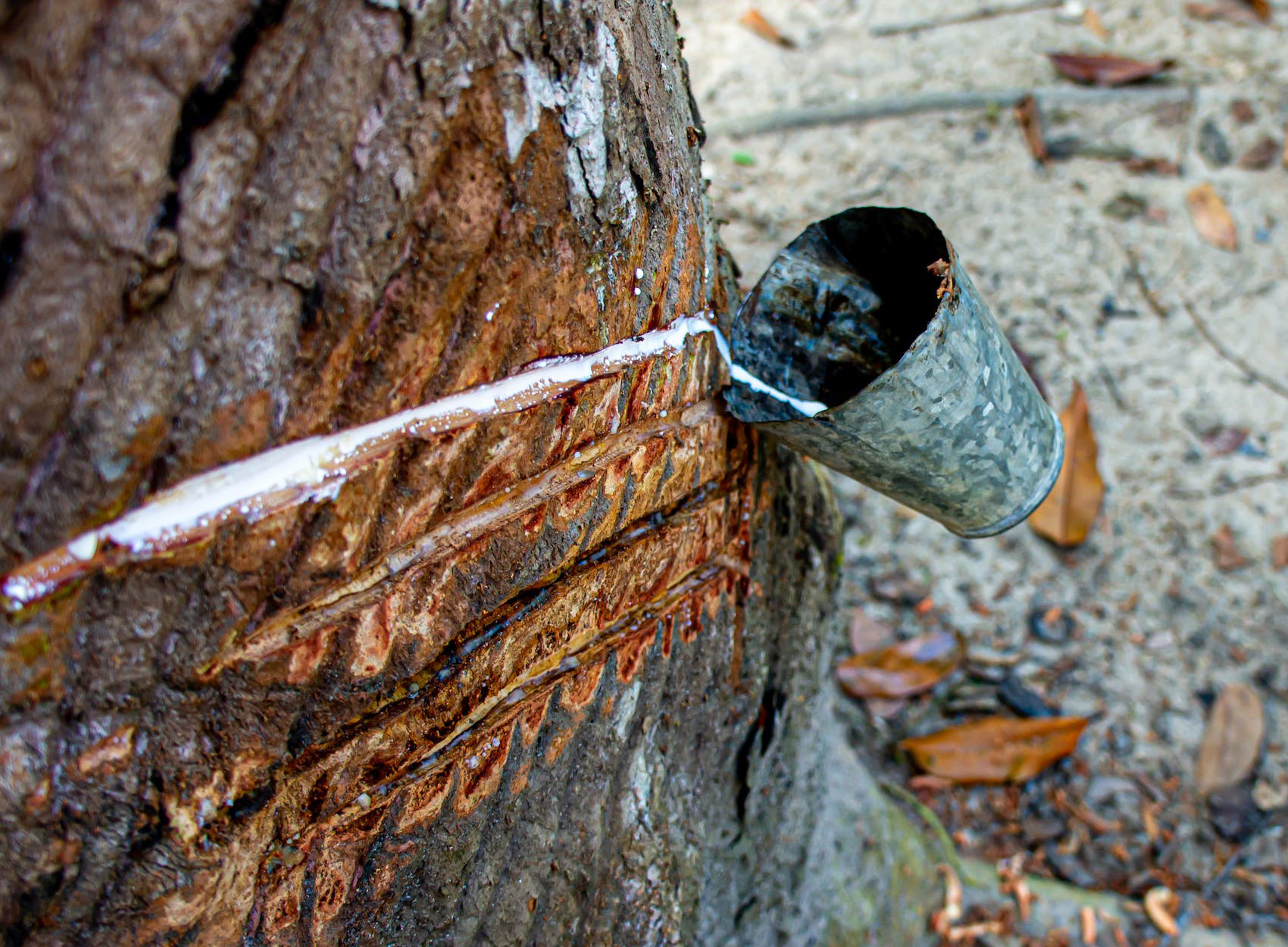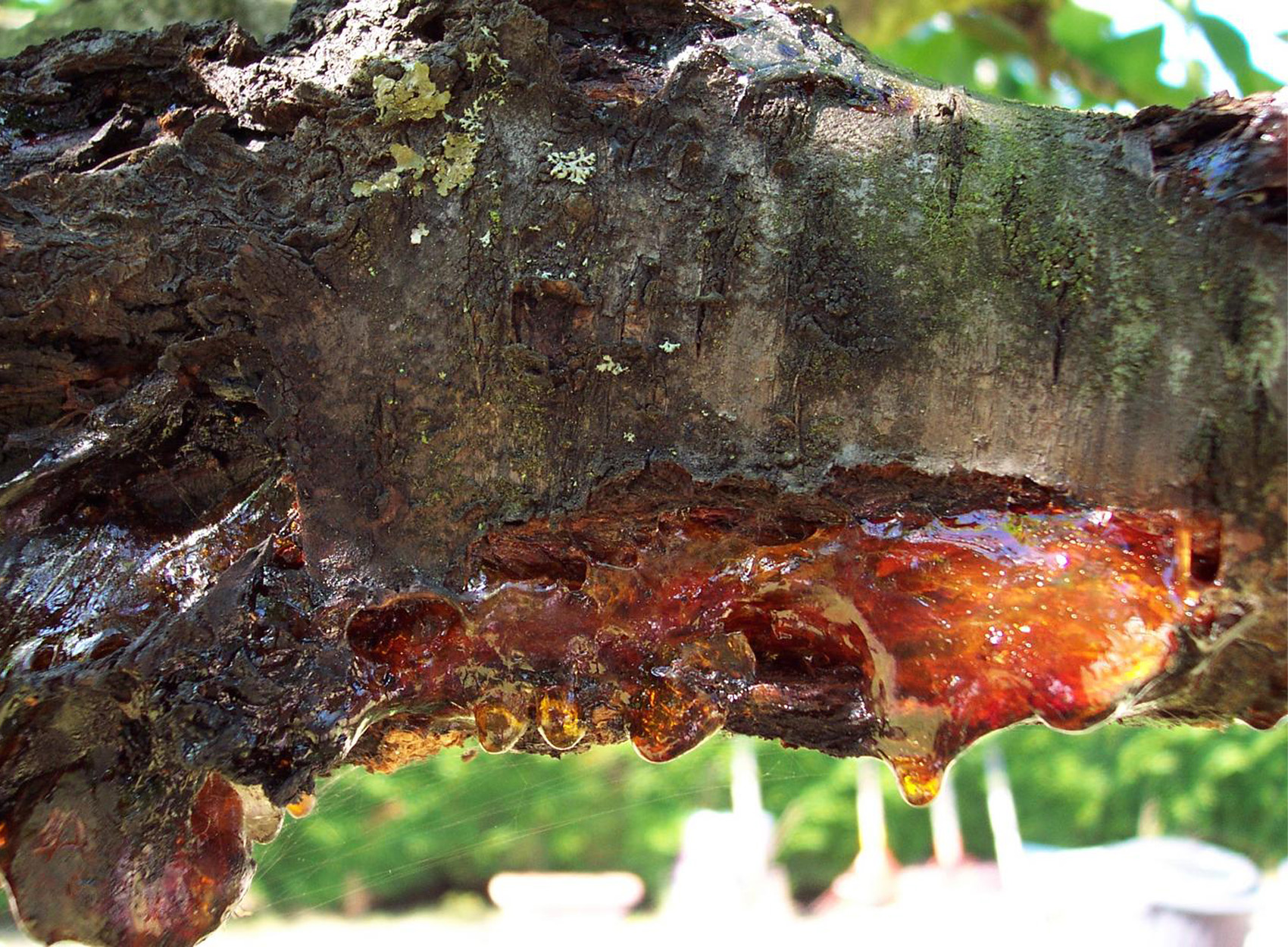What Is Tree Sap?
Tree sap contains sugar, vital nutrients and minerals which carry energy out to the branches where new buds are forming in spring-time. Without sap, a tree could not flower because it’s buds wouldn’t be fed these vital nutrients and minerals. Sap is actually made up of two different substances: xylem and phloem. Xylem transports water, hormones and minerals from the bottom of the tree to the top, from the roots to the leaves, in a long string like formation. Each year, old xylem channels die off and new ones are produced which forms a tree’s rings. When a tree is cut down you can tell it’s age by counting the rings. These rings are it’s old xylem pathways.
Phloem is the sticky sugary substance we think of as tree sap. It tastes sweet because it’s made up of the sugars created by photosynthesis. These sugars are then fed back into the tree, buds, branches and leaves as food during the tree’s growth period.
Phloem moves important nutrients from the leaves to other parts of the tree, such as the branches, roots, buds and fruit.
Sap is like the blood of a tree. Trees use their roots to suck up nutrients and water from soil. They absorb sunlight through their leaves and use the energy to make sugars from water, carbon dioxide gas and other ingredients. These sugars are actually food for trees. But sugar has to be transported throughout the tree where it’s needed most. This is what sap is for. It transports vital nutrients and food in the form of sugar.
All trees and plants have sap, but tree sap is thicker and gooier than plant sap. The most famous type of sap is produced by Maple trees which gives us maple syrup.
Do Trees Need Sap To Survive?
Yes, sap is like the blood of a tree and is essential for a tree’s survival. It’s sugar provides food and other essential nutrients like enzymes, water, hormones and minerals back to the tree when and where it’s needed most. Without sap, a tree would slowly die from malnutrition because it has not other way to feed itself.
Do All Trees Have Sap?
Yes, all trees and plants produce sap. It’s the blood of a tree and provides essential vital nutrients, water, enzymes, minerals, hormones and sugar back to the tree where and when it’s needed. Without sap a tree could not survive because it has no other way of feeding itself. Sap is a mixture of water, sugar and vital nutrients which is essentially food for the tree. Without sap the tree has no way of feeding itself or new buds.
Is Tree Sap Edible?
Yes, tree sap is edible after it’s been boiled and pasteurized to remove bacteria. However you probably wouldn’t want to eat it. Most sap isn’t sweet like maple syrup because it doesn’t have a high sugar content. It will likely taste bland, bitter or flavorless. Even Maple tree sap only has a sugar content of around 2%. It takes approximately 30 to 40 gallons of pure sap to produce a single gallon of Maple syrup once its been refined and boiled down to increase its sugar content. Even though tree sap is technically edible, it usually isn’t eaten because the taste isn’t great. Although it is nutritious.
The most common sap that’s eaten is Maple, Birch and Walnut. Other type of sap are not typically eaten because it doesn’t taste very well,. However most types of sap are still used in homeopathic remedies like teas and topical ointments.
What Does Tree Sap Taste Like?
Most tree sap has a low sugar content and isn’t sweet. Ut usually tastes bland, flavorless or bitter. Maple is the best tasting and most popular type of sap because it has a sugar content of around 2%. Raw Maple sap is a little bit sweet. But when it’s boiled down and refined to make Maple Syrup, it’s sugar content increases. It takes approximately 30 to 40 gallons of pure Maple sap to make a single gallon of Maple Syrup.
Maple syrup doesn’t just taste great, it also has health benefits like improving osteoporosis-like symptoms, preventing the formation of gastric ulcers, and lowering blood pressure.
In addition to Maple, Birch and Walnut are both saps that taste good enough to eat or use in a drink.
- Birch: Birch sap is slightly acidic, with a pH of between 5.5 and 7.5. It has a mild flavor with a subtle, natural sweetness. It’s a very good sap to boil down and drink as a tea. In fact many people call it Birch water because it’s so thin. It contains xylitol sugars, proteins, enzymes, amino acid and minerals. Birch has homeopathic healing properties, detox effects, and benefits for the liver and kidneys.
- Walnut: Walnut has a flavor similar to Maple. It’s a little less sweet but has a nuttier flavor. It’s great when refined into a syrup or put raw in teas. Black Walnut is one of my favorites.
Many other types of tree sap are boiled down and used in teas and other all natural remedies for it’s health properties but not its taste.
How Is Tree Sap Made?
Tree sap is made up of two different substances: xylem and phloem. Xylem is what transports water, hormones and minerals from the very bottom of the tree’s roots to the very top in a long string like formation. This is what produces a tree’s growth rings. Growth Rings are xylem channels used to transport water and other substances throughout the tree. As the tree grows larger each year, old xylem pathways die and new ones are created. This creates a new ring each year.
Phloem is the sticky sugary substance we think of as sap. Sap tastes sweet because it contains sugar produced by the tree during photosynthesis. This sugar is actually the tree’s food and provides energy. Photosynthesis occurs in the tree’s leaves when they absorb sunlight. But these sugars wouldn’t do much good unless they were transported to other parts of the tree that need food.
Sugar has to be transported throughout the tree where it’s needed most. This is what tree sap is for. Sugars produced during photosynthesis are fed back to the tree, buds, branches and leaves as food during the tree’s growth period.
Sap is made and transported in the outer layer of a tree just under the bark. Phloem moves important nutrients from the leaves to other parts of the tree, such as the branches, roots, buds and fruit through the trees outer most growth rings.
What’s The Purpose Of Tree Sap?
Sap is the blood of a tree. It carries vital nutrients, minerals hormones and energy throughout the tree to where it’s needed most. Sticky sap runs up and down the tree to branches providing energy to new buds that are forming during springtime. Without sap, a tree could not flower because its buds wouldn’t be fed vital nutrients and minerals.
During photosynthesis, sugars are created in the form of sap which is a tree’s food supply. These sugars are why sap tastes so sweet. Sugary sap travels throughout the tree providing food during its growth cycle.
Sap is an essential part of a tree’s health. Without sap a tree could not survive. Sap is what carries nutrients and food where it’s needed most during the tree’s growth period.
However sap can actually be an indicator that a tree is sick. When sap is leaking out of a tree and onto the bark, it can be a sign of damage, pests, or disease.
A common insect that causes damage to trees is the bark beetle. They burrow into the tree and lay eggs under the bark. When the eggs hatch the larvae carve out a network of deep burrows which can damage the tree. But trees have a defense. They leak their sap into the holes created by the beetle to fill them up before they can lay eggs. The sticky sap often traps the beetles and seals the holes before damage can be done.
If one of your trees is leaking sap it may be a sign of beetle infestation. To save the tree and get rid of the beetles you may need a chemical treatment.
What Time Of Year Do Trees Drip Sap?
You’ll see the most sap flow in Spring and early Summer as temperatures heat up. During winter, sap slows down and then picks back up again as Spring approaches. When the weather is warm, gas in the tree’s cells expands and pushes sap out of any punctures through the bark to seal them.
When taps are inserted into a tree, sap runs through the tap and into a bucket. As long as the tap stays open, the tree’s sap will continue to run as long as it stays warm and there’s still excess sap in the tree. When the temperature turns cold, the tree’s pressure is lowered and the sap stops flowing.
What Does Sap Taste Like?
Sap tastes sweet because it contains sugar. Have you ever tasted sweet maple syrup? If you have then you know what sap tastes like because it’s made from the sap of a maple tree. Sap is actually food for the tree. It contains sugar which is fed back to the tree for energy where and when its needed most.
Sugar is produced during photosynthesis when leaves absorb lots of sunlight energy. Sap is stored and carried just under the bark by the outer most growth rings. A Sugar Maple is a very popular sap producing tree that can make as much as 15 gallons of sap when tapped in early Spring with a 2% sugar content. Some trees can produce as much as 80 gallons of sap per year. This is where maple syrup comes from.
As the temperatures rise in Spring, sap flows more freely out of any holes in the tree and stops when temperatures drop at night. Taps are inserted through the bark and into the growth rings to provide a place for sap to flow. During the day, it flows out of the tap and into a bucket. It’s then refined and turned into maple syrup.
It takes 30 to 40 gallons of tree sap to produce just 1 gallon of pancake syrup once its been refined and boiled down.
What Trees Produce Edible Sap?
The most famous type of tree that produces edible sap is the Sugar Maple. Its sap has a sugar content of up to 2% and is used to produce sweet Maple Syrup. The trees are tapped in late winter and early spring and can produce as much as 15 gallons per tap with some large trees producing 80 gallons per year. The Sugar Maple is the most widely used for sap production because its sugar content is so high, but every Maple produces edible sap with varying degrees of sweetness.
- In Korea the Gorosoe is the most common source of sap. Its traditionally consumed raw as a hot beverage rather than boiled down into syrup.
- The White Walnut, Black Walnut and English Walnut all produce sugary sap that’s edible.
- The sap of many Birches is a great source of minerals and natural antioxidants but its low on sugar which is why most people don’t eat it.
- Walnut saps are regarded for their healthy properties which includes minerals, enzymes, antioxidants, and nutrients.
- Pine sap is used for homeopathic remedies and natural chews but it’s not usually eaten.
Sap contains sugar and many other healthy ingredients like enzymes, minerals and antioxidants. Even if a tree’s sap isn’t edible, it’s likely still useful for a variety of all natural remedies and treatments.
How To Remove Sap
Sap is very sticky and hard to clean off clothes, hair or your hands. Clean it off as soon as you can because it gets a lot more difficult to remove once it hardens.
- Skin: To remove it from skin, rub with acetone (nail polish remover), rubbing alcohol or gasoline. Then wash with soap and water.Be careful if you use gas because it’s flammable. You may want to moisturize afterwards because acetone and rubbing alcohol will dry out your skin.
- Hair: Coat your hair with peanut butter and massage the effected area until it comes loose. Peanut butter will counter the sap’s stickiness and pull it free from your hair when you wash it. Wash your hair with regular shampoo.
- Clothes: Use rubbing alcohol on the affected area. Then put the clothing through a warm wash with regular detergent.
Tree sap is like blood for tress and vital to their good health. It provides essential nutrients, food, hormones and minerals throughout the tree where it’s needed most. But it can be a nuisance if it gets onto your clothing, skin or hair because of how sticky it is.
If you’re working on or around trees, be aware of the season and temperature. Sap flows during warm weather in the Spring and Summer but slows down or stops altogether in Fall and Winter.
How To Clean Sap Off A Car
There are trees that may drip sap from its branches during warm days in Spring and Summer. If that sap should get onto a car it can be tricky to remove. Try to clean it off as soon as possible before it hardens. Once sap gets dry and hard it becomes a lot harder to remove and can damage paint, a clear coat or a canvas convertible top.
- Soap: First try cleaning your car with warm soapy water. If you notice the sap right after it dripped soap will usually do the trick. Especially if you’ve recently waxed the car.
- WD-40: A mild solvent like WD-40 will break up sap’s grip on your car. But be careful how you use it. Spray some onto a rag and carefully use the rag to clean the area. Don’t spray WD-40 directly onto the car or get it on the car with your rag. Then wash the area with warm soapy water.
Don’t use acetone or alcohol on your paint job because it can damage the cars paint and/or clear coat.
Soap and WD-40 will work on a car body or convertible soft top. Just be careful not to get solvent on anything but the sap. It usually won’t damage a newer car’s paint job because of the clear coat but if the coating is warn down it might.
Does Draining Sap Hurt A Tree?
No, tapping a tree to drain its sap does not endanger the health of the tree. Tapping creates some small damage where the tap enters the tree through the bark, but its a wound the tree can easily heal and does not endanger it. Syrup producers tap the same trees for decades without adversely affecting their health. A healthy tree will heal and grow over the area in a year.
There’s also no risk of draining too much sap because trees constantly produce it in ample amounts. If the tree is low on sap it will simply stop draining from the tap until more is produced.
Why Does Sap Run Out Of Trees?
When the weather is warm, gas in the tree’s cells expands and pushes sap out of any punctures through the bark to seal them. When taps are inserted into a tree, sap runs through the tap and into a bucket. As long as the tap stays open, the tree’s sap will continue to run as long as it stays warm and there’s still excess sap in the tree. When the temperature turns cold, the tree’s pressure is lowered and the sap stops flowing.
Sap can also run from a tree as a defense mechanism against pests. A common cause of tree damage are bark beetles. They burrow into the tree and lay eggs. When the larvae hatch they burrow into the tree and create a home. I defense, the tree pushes out sap to fill the beetles holes before they can lay eggs and hatch.
If a tree is damaged by other means, such as in a storm or scratched by an animal, sap can run to seal the damaged area.
What Happens If You Boil Tree Sap?
Boiling tree sap is what turns it into a syrup. Sap in a mixture of water, sugar and other nutrients. Boiling it down removes some of the excess water and consolidates the sugars which makes it taste sweeter. It takes approximately 30 to 40 gallons of pure maple sap to create 1 gallon of maple syrup.
Boiling is also a great way to pasteurize sap so you can eat it or put it on a wound. Tree sap taken directly from the tree can contain harmful bacteria or yeast. Boiling makes it safe to consume or turn into a natural remedy or ointment.
Is Sap Toxic To Humans?
No, sap is actually healthy for humans to consume if boiled down and pasteurized before consuming or placing it on a wound. Sap contains beneficial nutrients like enzymes, antioxidants and minerals. Its been used for centuries around the world as a sugary syrup or in homeopathic remedies and topical ointments.
Can You Eat Sap From Any Tree?
Yes, you can eat sap from any tree after it’s been boiled and pasteurized to remove bacteria, however you probably wouldn’t want to. Most sap isn’t sweet like maple syrup because it doesn’t have a high sugar content. It will likely taste bland, bitter or flavorless. Even Maple tree sap only has a sugar content of around 2%. It takes approximately 30 to 40 gallons of pure sap to produce a single gallon of Maple syrup once its been refined and boiled down to increase its sugar content. Even though tree sap is technically edible, it usually isn’t eaten because the taste isn’t great. Although it is nutritious.
The most common sap that’s eaten is Maple, Birch and Walnut. Other type of sap are not typically eaten because it doesn’t taste very well. However most types of sap are still used in homeopathic remedies like teas and topical ointments.
Can You Start A Fire With Tree Sap?
Yes, you can start a fire or extend the burn time of a fire with the right type of tree sap. Ponderosa pine tree resin as well as sap taken from many other pine trees can be used as a turpentine fire starter or to prolong the burn time of a torch or camp fire. Simply cover your torch wood in sap before you light it.
Summary: What Is Tree Sap?
Tree sap contains sugar, vital nutrients and minerals which carry energy out to the branches where new buds are forming in spring-time. Without sap, a tree could not flower because it’s buds wouldn’t be fed these vital nutrients and minerals. Sap is actually made up of two different substances: xylem and phloem. Xylem transports water, hormones and minerals from the bottom of the tree to the top, from the roots to the leaves, in a long string like formation. Each year, old xylem channels die off and new ones are produced which forms a tree’s rings. When a tree is cut down you can tell it’s age by counting the rings. These rings are it’s old xylem pathways.
Phloem is the sticky sugary substance we think of as tree sap. It tastes sweet because it’s made up of the sugars created by photosynthesis. These sugars are then fed back into the tree, buds, branches and leaves as food during the tree’s growth period.
Phloem moves important nutrients from the leaves to other parts of the tree, such as the branches, roots, buds and fruit.
Sap is like the blood of a tree. Trees use their roots to suck up nutrients and water from soil. They absorb sunlight through their leaves and use the energy to make sugars from water, carbon dioxide gas and other ingredients. These sugars are actually food for trees. But sugar has to be transported throughout the tree where it’s needed most. This is what sap is for. It transports vital nutrients and food in the form of sugar.
All trees and plants have sap, but tree sap is thicker and gooier than plant sap.
If you have any questions email any time.
